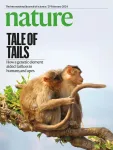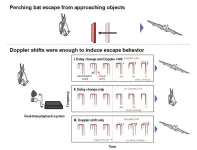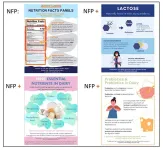(Press-News.org) A genetic change in our ancient ancestors may partly explain why humans don’t have tails like monkeys, finds a new study led by researchers at NYU Grossman School of Medicine.
Published online February 28 as the cover story of the journal Nature, the work compared the DNA of tail-less apes and humans to that of tailed monkeys, and found an insertion of DNA shared by apes and humans, but missing in monkeys. When the research team engineered a series of mice to examine whether the insertion, in a gene called TBXT, affected their tails, they found a variety of tail effects, including some mice born without tails.
“Our study begins to explain how evolution removed our tails, a question that has intrigued me since I was young,” says corresponding study author Bo Xia, PhD, a student at the time of the study in the labs of study senior co-authors Jef D. Boeke, PhD, and Itai Yanai, PhD at NYU Grossman School of Medicine. Xia is now a junior fellow of the Harvard Society of Fellows, and a principal investigator at the Broad Institute of MIT and Harvard.
More than 100 genes had been linked by past work to the development of tails in various vertebrate species, and the study authors hypothesized that tail loss occurred through changes in the DNA code (mutations) of one or more of them. Remarkably, say the study authors, the new study found that the differences in tails came not from TBXT mutations, but instead from the insertion of a DNA snippet called AluY into the gene’s regulatory code in the ancestors of apes and humans.
Profound Surprise
The new finding proceeds from the process by which genetic instructions are converted into proteins, the molecules that make up the body’s structures and signals. DNA is “read” and converted into a related material in RNA, and ultimately into mature messenger RNA (mRNA), which produces proteins.
In a key step that produces mRNA, “spacer” sections called introns are cut out of the code, but before that guide the stitching together (splicing) of just the DNA sections, called exons, which encode the final instructions. Further, the genomes of vertebrate animals evolved to feature alternative splicing, in which a single gene can code for more than one protein by leaving out or adding exon sequences. Beyond splicing, the human genome grew more complex still by evolving to include “countless” switches, part of the poorly understood “dark matter” that turns on genes at different levels in different cell types.
Still other work has shown that half of this non-gene “dark matter” in the human genome, which lies both between genes and within the introns, consists of highly repeated DNA sequences. Further, most of these repeats consist of retrotransposons, also called “jumping genes” or “mobile elements,” which can move around and insert themselves repeatedly and randomly in human code.
Pulling these details together, the “astounding” current study found that the transposon insertion of interest, AluY, which affected tail length, had randomly occurred in an intron within the TBXT code. Although it did not change a coding portion, the intron insertion, so the research team showed, influenced alternative splicing, something not seen before, to result in a variety of tail lengths. Xia found an AluY insertion that remained in the same location within the TBXT gene in humans and apes resulted in the production of two forms of TBXT RNA. One of these, they theorize, directly contributed to tail loss.
“This finding is remarkable because most human introns carry copies of repetitive, jumping DNAs without any effect on gene expression, but this particular AluY insertion did something as obvious as determine tail length,” said Boeke, the Sol and Judith Bergstein Director of the Institute for System Genetics at NYU Langone Health.
Tail loss in the group of primates that includes gorillas, chimpanzees, and humans is believed to have occurred about 25 million years ago, when the group evolved away from Old World monkeys, said the authors. Following this evolutionary split, the group of apes that includes present-day humans evolved the formation of fewer tail vertebrae, giving rise to the coccyx, or tailbone. Although the reason for the tail loss is uncertain, some experts propose that it may have better suited life on the ground than in the trees.
Any advantage that came with tail loss was likely powerful, the researchers say, because it may have happened despite coming with a cost. Genes often influence more than one function in the body, so changes that bring an advantage in one place may be detrimental elsewhere. Specifically, the research team found a small uptick in neural tube defects in mice with the study insertion in the TBXT gene.
“Future experiments will test the theory that, in an ancient evolutionary trade-off, the loss of a tail in humans contributed to the neural tube birth defects, like those involved in spinal bifida, which are seen today in one in a thousand human neonates,” said Yanai, also in the Institute for Systems Genetics.
In addition to Xia, Boeke and Yanai, other NYU Langone study authors were Weimin Zhang, Guisheng Zhao, Ran Brosh, Aleksandra Wudzinska, Emily Huang, Hannah Ashe, Gwen Ellis, Maayan Pour, Yu Zhao, Camila Coelho, Yinan Zhu, Alexander Miller, Jeremy Dasen, Matthew Maurano, and Sang Yong Kim. The mouse engineering work was supported by the NYU Langone Health Rodent Genetic Engineering Laboratory (RGEL) led by Dr. Sang Yong Kim. The study was funded by NYU Langone research fund and National Institutes of Health grants RM1HG009491, P01AG051449, DP5OD033430, and R35GM119703, and by NYSTEM predoctoral fellowship C322560GG.
END
Change in gene code may explain how human ancestors lost tails
Mechanism behind change may reveal new role for parts of the genetic code
2024-02-28
ELSE PRESS RELEASES FROM THIS DATE:
Risk of hospital readmission after surgery is high for older Americans
2024-02-28
New Haven, Conn. — A new Yale study finds an increased risk of hospital readmission for older Americans within 180 days of undergoing major surgery — a risk that is particularly acute for individuals who are frail or have dementia.
The findings were published Feb. 28 in the journal JAMA Network Open.
Previous research by the same Yale team demonstrated that major surgery is a common event for older Americans and also demonstrated a heightened mortality risk within one year of major surgery for people who are age 65 and older. The new study is the first to describe both the short-term risk (within 30 days) and longer-term ...
How molecular “handedness” emerged in early biology
2024-02-28
LA JOLLA, CA—Molecules often have a structural asymmetry called chirality, which means they can appear in alternative, mirror-image versions, akin to the left and right versions of human hands. One of the great mysteries about the origins of life on Earth is that virtually all of the fundamental molecules of biology, such as the building blocks of proteins and DNA, appear in just one chiral form.
Scripps Research chemists, in two high-profile studies, have now proposed an elegant solution to this mystery, showing how this single-handedness or “homochirality” could have become established in biology.
The studies were published in the Proceedings ...
The James Webb Space Telescope reveals the central role of low-mass galaxies in the reionization process of the Universe
2024-02-28
PARIS, France and BEER-SHEVA, Israel, February 28, 2024 – The James Webb Space Telescope (JWST)[1], developed by NASA and ESA, has just obtained the first spectra of very low-mass galaxies less than a billion years after the Big Bang. A technological feat made possible by the unique combination of JWST sensitivity and the gravitational lensing effect of the Abell 2744 cluster: nearby galaxies act like cosmic magnifiers, distorting space and amplifying the light of background galaxies. By demonstrating that small galaxies are very likely at the origin of the reionization of the universe, this discovery represents a major breakthrough in our knowledge of the cosmos.
The international research ...
Immunotherapy combination may benefit patients with transplanted kidneys and advanced skin cancers
2024-02-28
People who have had a kidney transplant are at high risk for developing skin cancers. New research directed by investigators from the Johns Hopkins Kimmel Cancer Center is exploring the best combination of treatments to target skin cancers while preserving the transplanted organs.
Now, they report results from a clinical trial testing a novel drug combination designed to stimulate the immune system to fight advanced, potentially lethal skin cancers while not permanently damaging patients’ transplanted kidneys. The treatment included two immune-suppressing drugs ...
Nature’s sonar: Scientists reveal how Japanese horseshoe bats perceive moving objects
2024-02-28
Unlike most animals that rely on visual senses, bats navigate and locate prey or obstacles through echolocation. By emitting sounds and comparing them to the reflected echoes, bats can “visualize” movement in the environment. When sound waves encounter a moving object, they can undergo changes such as a Doppler shift in frequency or experience a delay, which the bat can sense. However, it is unclear which acoustic characteristics bats rely on to detect moving objects.
Japanese horseshoe bats (Rhinolophus ferrumequinum nippon) emit ultrasound pulses that are characterized ...
Dimensions Research GPT – evidence-based research insights for ChatGPT platform users
2024-02-28
Digital Science is pleased to announce the launch of two new products – Dimensions Research GPT and Dimensions Research GPT Enterprise – bringing the unmatched, trusted research coverage of Dimensions to the ChatGPT platform.
Users can get AI-generated answers to research-related questions on the GPT platform informed by Dimensions’ huge database, making ChatGPT more research-specific for topic exploration.
Available to users of both the free and paid Dimensions Analytics web application, Dimensions Research GPT and Dimensions Research GPT Enterprise help overcome ...
Calcium crystal deposits in the knee contribute to joint damage
2024-02-28
(Boston)— Knee osteoarthritis (OA) is the most common form of arthritis, affecting approximately 600 million people worldwide and 34 million people in the U.S. There are no treatments available that prevent its progression to date. Recommended pharmacological treatments for symptoms have either small-to moderate effects or short-term effects, often with side effects, and lifestyle behaviors such as exercise and weight loss are under-utilized.
Historically, intra-articular mineralization (IAM) or calcium crystal deposits in the joint, were thought to be of no clinical consequence, and perhaps just something that happens with older ...
International team led by BSC develops artificial intelligence technology to improve treatment of rare diseases
2024-02-28
An international team of scientists led by ICREA researcher and Director of the Life Sciences Department at the Barcelona Supercomputing Centre - Centro Nacional de Supercomputación (BSC-CNS), Alfonso Valencia, has developed a technology based on artificial intelligence (AI) for the study of minority diseases and has successfully applied it to identify the possible causes of the appearance of what are known as myasthenic-congenital syndromes, a group of rare inherited disorders that limit the ability to move and cause varying degrees of muscle weakness in patients.
The lack of available data on minority, also known as rare, diseases makes research in this area extremely ...
Anti-cancer drug could improve symptoms after stroke
2024-02-28
A study by the Institut de Neurociències of the UAB (INc-UAB) demonstrates in animal models the benefits of vorinostat after having suffered a stroke. The drug, used in humans to treat cutaneous T-cell lymphoma, has been proved to mitigate brain injuries and help in restoring brain tissue.
Ischemic stroke is the second leading cause of death worldwide and occurs when blood flow cannot reach the brain due to an obstruction. For a more or less long period of time, the brain does not receive oxygen and this causes damage and functional impairment. Hypertension is the most frequent modifiable risk factor for stroke and is associated with worse recoveries.
Currently, ...
Consumers empowered with the facts on dairy’s nutritional benefits buy and consume more dairy foods
2024-02-28
Philadelphia, February 28, 2024 – Although most Americans consume dairy and many dairy foods are rising in popularity, fluid milk consumption has seen a significant decline among US consumers since the 1960s. To reverse this trend—and ensure consumers are getting adequate amounts of dairy in their diets—the dairy sector has developed educational materials to reach consumers through informational infographics and TV and print ads, and on social media. But do these kinds of educational ...
LAST 30 PRESS RELEASES:
AI overestimates how smart people are, according to HSE economists
HSE researchers create genome-wide map of quadruplexes
Scientists boost cell "powerhouses" to burn more calories
Automatic label checking: The missing step in making reliable medical AI
Low daily alcohol intake linked to 50% heightened mouth cancer risk in India
American Meteorological Society announces Rick Spinrad as 2026 President-Elect
Biomass-based carbon capture spotlighted in newly released global climate webinar recording
Illuminating invisible nano pollutants: advanced bioimaging tracks the full journey of emerging nanoscale contaminants in living systems
How does age affect recovery from spinal cord injury?
Novel AI tool offers prognosis for patients with head and neck cancer
Fathers’ microplastic exposure tied to their children’s metabolic problems
Research validates laboratory model for studying high-grade serous ovarian cancer
SIR 2026 delivers transformative breakthroughs in minimally invasive medicine to improve patient care
Stem Cell Reports most downloaded papers of 2025 highlight the breadth and impact of stem cell research
Oxford-led study estimates NHS spends around 3% of its primary and secondary care budget on the health impacts of heat and cold in England
A researcher’s long quest leads to a smart composite breakthrough
Urban wild bees act as “microbial sensors” of city health.
New study finds where you live affects recovery after a hip fracture
Forecasting the impact of fully automated vehicle adoption on US road traffic injuries
Alcohol-related hospitalizations from 2016 to 2022
Semaglutide and hospitalizations in patients with obesity and established cardiovascular disease
Researchers ‘listen in’ to embryo-mother interactions during implantation using a culture system replicating the womb lining
How changing your diet could help save the world
How to make AI truly scalable and reliable for real-time traffic assignment?
Beyond fragmented markets: A new framework for efficient and stable ride-pooling
Can shape priors make road perception more reliable for autonomous driving?
AI tracks nearly 100 years of aging research, revealing key trends and gaps
Innovative techniques enable Italy’s first imaging of individual trapped atoms
KIER successfully develops Korea-made “calibration thermoelectric module” for measuring thermoelectric device performance
Diversifying US Midwest farming for stability and resilience
[Press-News.org] Change in gene code may explain how human ancestors lost tailsMechanism behind change may reveal new role for parts of the genetic code





